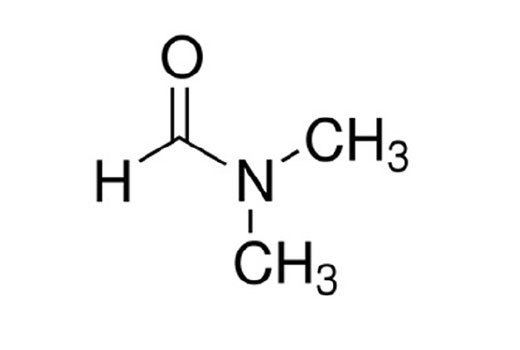3DMet B00545 Boiling point 153 °C Formula C3H7NO Melting point -61 °C | Appearance Colourless liquid Density 944 kg/m³ Molar mass 73.09 g/mol IUPAC ID N,N-Dimethylmethanamide | |
 | ||
Related alkanamides Related compounds Thermodynamicdata Phase behavioursolid–liquid–gas | ||
Dimethylformamide
Dimethylformamide is an organic compound with the formula (CH3)2NC(O)H. Commonly abbreviated as DMF (although this acronym is sometimes used for dimethylfuran, or dimethyl fumarate), this colourless liquid is miscible with water and the majority of organic liquids. DMF is a common solvent for chemical reactions. Dimethylformamide is odorless whereas technical grade or degraded samples often have a fishy smell due to impurity of dimethylamine. As its name indicates, it is a derivative of formamide, the amide of formic acid. DMF is a polar (hydrophilic) aprotic solvent with a high boiling point. It facilitates reactions that follow polar mechanisms, such as SN2 reactions.
Contents
- Dimethylformamide
- Structure and properties
- Reactions
- Production
- Applications
- Niche uses
- Safety
- Toxicity
- References
Structure and properties
As for most amides, the spectroscopic evidence indicates partial double bond character for the C-N and C-O bonds. Thus, the infrared spectrum shows a C=O stretching frequency at only 1675 cm−1, whereas a ketone would absorb near 1700 cm−1. The methyl groups are inequivalent on the NMR time scale, giving rise to two singlets of 3 protons each at δ 2.97 and 2.88 in the proton NMR spectrum in chloroform-d.
DMF is miscible with water. The vapour pressure at 20 °C is 3.5hPa. A Henry's law constant of 7.47×10−5 hPa·m3/mol can be deduced from an experimentally determined equilibrium constant at 25 °C. The partition coefficient logPOW is measured to −0.85. Since the density of DMF (0.95 g/cm3 at 20 °C) is very similar to that of water, significant flotation or stratification in surface waters in case of accidental losses is not expected.
Reactions
DMF is hydrolyzed by strong acids and bases, especially at elevated temperatures. With sodium hydroxide, DMF converts to formate and dimethylamine. DMF undergoes decarbonylation near its boiling point to give dimethylamine. Distillation is therefore conducted under reduced pressure at lower temperatures.
In one of its main uses in organic synthesis, DMF is a reagent in the Vilsmeier-Haack reaction, which is used to formylate aromatic compounds. The process involves initial conversion of DMF to N,N-dimethyliminium chloride, (CH3)2N=C(Cl)H+, which attacks arenes.
Organolithium compounds react with DMF to give, after hydrolysis, aldehydes.
Production
DMF is prepared by combining methyl formate and dimethylamine or by reaction of dimethylamine with carbon monoxide.
Although currently impractical, DMF can be prepared from supercritical carbon dioxide using ruthenium-based catalysts.
Applications
The primary use of DMF is as a solvent with low evaporation rate. DMF is used in the production of acrylic fibers and plastics. It is also used as a solvent in peptide coupling for pharmaceuticals, in the development and production of pesticides, and in the manufacture of adhesives, synthetic leathers, fibers, films, and surface coatings.
Niche uses
As a common and cheap reagent, DMF has many uses in the research laboratory.
Safety
Reactions including the use of sodium hydride in DMF as a solvent are somewhat hazardous; exothermic decompositions have been reported at temperatures as low as 26 °C. On a laboratory scale any thermal runaway is (usually) quickly noticed and brought under control with an ice bath and this remains a popular combination of reagents. On a pilot plant scale, on the other hand, several accidents have been reported.
Toxicity
The potential toxicity of DMF has received considerable attention. It is not classified as human carcinogen (A4), but it is thought to cause birth defects. In some sectors of industry, women are banned from working with DMF. For many reactions, it can be replaced with dimethyl sulfoxide. Most manufacturers of DMF list 'Life' or 'Chronic' as a health hazard in their MSDS since DMF is not readily disposed of by the body. According to IARC, DMF is not classified as to its carcinogenicity to humans, and the United States Environmental Protection Agency does not consider it a cancer risk.
